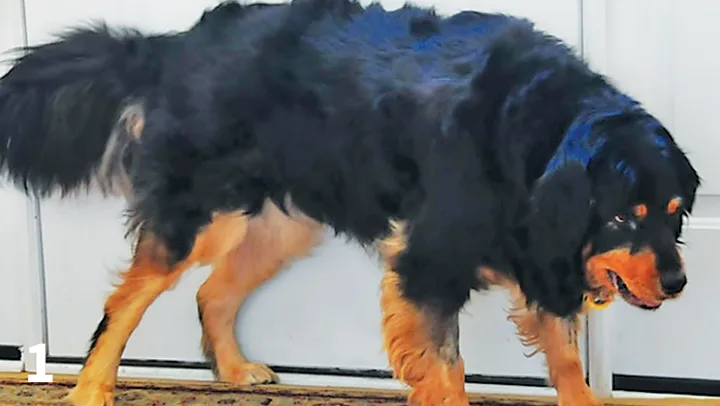MDR1 Gene Mutations & Drug Therapy
Katrina L. Mealey, DVM, PhD, DACVIM, DACVCP, Washington State University

The MDR1 (ABCB1) gene encodes P-glycoprotein, a drug transporter that plays a key role in drug disposition. P-glycoprotein, a critical component of the blood-brain barrier, prevents entry of many potentially toxic compounds into the CNS.1 P-glycoprotein also promotes drug excretion into bile and urine.1
What do I need to know about the MDR1 gene?
Defective P-glycoprotein function can lead to severe, potentially fatal, adverse drug reactions because of enhanced CNS exposure to drugs (lack of functional P-glycoprotein at the blood-brain barrier)2,3 or enhanced systemic exposure to drugs (lack of P-glycoprotein-mediated biliary and/or renal drug excretion).4,5
Homozygous/Heterozygous
Homozygous = mutant/mutant:
Affected animals have 2 copies of the mutant allele and always pass 1 copy of the defective gene to offspring. Homozygotes are more likely to have severe (life-threatening) adverse drug reactions.
Heterozygous = mutant/normal
Affected animals have 1 copy of the mutant allele and 1 copy of the normal allele and have a 50% chance of passing the defective gene to offspring. Heterozygotes tend to have less severe adverse drug reactions as compared with homozygotes.
What are the causes of P-glycoprotein dysfunction?
Distinct mutations of the MDR1 gene have been described in both dogs2 and cats.6 In dogs, a 4-base pair deletion mutation known as the MDR1 mutation or ABCB1-1Δ creates a stop codon that prematurely terminates P-glycoprotein synthesis.2 Dogs that are homozygous for this mutation have no P-glycoprotein function, whereas heterozygotes have partial P-glycoprotein function. In cats, a 2-base pair MDR1 deletion known as _ABCB1_1930_1931del TC creates a premature stop codon that can lead to an abnormally truncated P-glycoprotein, with similar impairments of P-glycoprotein function as those described in dogs.6
Defective P-glycoprotein function can occur in dogs and cats with MDR1 mutations but can also result from drug-drug interactions.4,7 Several commonly used drugs can inhibit P-glycoprotein function, even in animals with normal MDR1 gene structure. Consequently, veterinarians may encounter dogs and cats with intrinsic (genetically mediated) P-glycoprotein dysfunction, as well as with extrinsic, or acquired, P-glycoprotein dysfunction (animals receiving a drug that inhibits P-glycoprotein function).
To avoid causing P-glycoprotein–associated adverse drug reactions, veterinarians should consider all potential causes of P-glycoprotein dysfunction—both intrinsic and acquired.
Which drugs should be avoided or used at reduced doses?
Not all drugs must be avoided in animals with altered P-glycoprotein function; many drugs can be used safely with no need to alter dose. However, animals with altered P-glycoprotein function have been documented to experience enhanced toxicity to the drugs listed in Table 1.
Table 1: Drugs to Avoid or Use at Reduced Doses2,3,5,7-13
Antiparasitic
Chemotherapeutic
Gastrointestinal
*At extralabel doses only; label doses for heartworm prevention in dogs and cats are safe.
Which drugs inhibit P-glycoprotein?
In MDR1 wild-type dogs (and presumably cats), ketoconazole and spinosad are most often associated with severe adverse effects because of their ability to inhibit P-glycoprotein function.4,7,14 Ivermectin toxicosis has been documented in MDR1 wild-type dogs receiving ivermectin in combination with either ketoconazole or spinosad.15 In addition, severe vinblastine toxicosis was documented in an MDR1 wild-type dog concurrently receiving ketoconazole.7
Which dog breeds are affected?
The MDR1 mutation has been identified primarily in dogs of herding breed ancestry. In fact, all dogs affected by MDR1 are thought to be descendants of a single dog that lived in Great Britain before the genetic isolation of breeds.16 Table 2, lists breeds and approximate frequency of the MDR1 mutation.
Table 2: Approximate Frequency of MDR1 Gene Mutations8,16,18
Can mixed breeds be affected?
Mixed breeds can be affected because dogs only need to receive 1 copy of the mutant MDR1 allele from a parent with at-risk breed lineage. Thus, a dog with any herding breed in its ancestry may have the MDR1 mutation and be at risk for drug toxicity. The author is aware of many mixed-breed dogs that can harbor the MDR1 mutation despite having no obvious physical characteristics that would suggest herding breed ancestry (Figure 1). Based on anecdotal clinical findings and observations, many mixed-breed dogs have experienced serious adverse effects because they were treated with P-glycoprotein drugs before being tested for the MDR1 mutation.8

Example of a mixed-breed dog with MDR1 mutant/mutant genotype. Physical characteristics of herding breeds are not always apparent.
Why are clients with pets affected by MDR1 mutation apprehensive about using drugs?
Clients with pets affected by the MDR1 mutation may be apprehensive about giving any drug to their pet. This reluctance may be caused by accessing false information:
The information cited on some websites is unreliable and inaccurate. For example, based on in vitro studies of drugs experimentally shown to be transported by P-glycoprotein or on studies conducted in rodents or humans (not in dogs and cats), some websites may falsely cite drugs as being unsafe to use in animals with P-glycoprotein dysfunction.17
Most of the nearly 100 drugs that could fit criteria cited in these studies do not cause toxicity in animals with P-glycoprotein dysfunction. Many (eg, cephalosporins, penicillins, tetracyclines, antihistamines, ß-adrenergic antagonists) have 1 or more characteristics that allow for safe use in animals with P-glycoprotein dysfunction, including:
Wide therapeutic margin
Minimal neurologic toxicity
Alternate drug clearance mechanisms
Ability to be pumped by a different drug transporter
Metronidazole is inappropriately listed by many websites as a drug that should not be used in animals with P-glycoprotein dysfunction.
Although metronidazole can cause neurologic toxicity, it is not transported by P-glycoprotein.
Rather, the risk for toxicity increases with increased dose and duration of therapy19 and is not related to P-glycoprotein function.
In addition, websites may inappropriately state that ivermectin should never be used in dogs and cats.
Ivermectin administered at the manufacturer’s label dose can be used in dogs, including herding breeds, with MDR1 mutation.20
All FDA-approved heartworm prevention products licensed in the United States have been tested and found to be safe in dogs with MDR1 mutation. (For study results, see label indications for specific trademark products.)
Example: The ivermectin monthly dose of 6 µg/kg for heartworm prevention is ≈20 times lower than the dose of ivermectin that could cause neurologic toxicity in dogs with MDR1 mutation (anecdotal).2,8,21
Note: Doses of ivermectin used to treat mange (300-600 µg/kg) should not be used in dogs with heterozygous or homozygous MDR1 mutation.
Is pesticide use a problem in affected animals?
Abamectin (similar to ivermectin) is the active ingredient in many pesticides licensed for both indoor (eg, ant bait, roach bait) and outdoor (eg, premise sprays) use. These products can cause severe neurologic toxicity in dogs with MDR1 mutation.8 Animals with the MDR1 mutation should avoid contact with these products. Clinical signs in dogs are similar to those observed with ivermectin toxicosis. The author is unaware of specific abamectin toxicities in cats, but clinical signs are expected to be similar to those seen with ivermectin.
Leading Research & Updates
The Veterinary Clinical Pharmacology Laboratory (VCPL) at Washington State University discovered the MDR1 mutation in both dogs and cats.2,6 This laboratory continues to lead research efforts in determining which drugs should be avoided in animals with P-glycoprotein dysfunction and provides key information on its website (Veterinary Clinical Pharmacology Laboratory), including an up-to-date list of drugs known to cause toxicity in animals with P-glycoprotein dysfunction and with drugs that should be used cautiously in animals with P-glycoprotein dysfunction. A list of peer-reviewed research articles from veterinary and scientific journals, as well as veterinary textbooks that provide supportive and more detailed information, is also available on the website.22-24
Conclusion
Pharmacologic treatment of dogs or cats with P-glycoprotein dysfunction involves either decreasing drug doses or considering alternate drugs. Failure to consider MDR1 genotype or drug-drug interactions that result in P-glycoprotein dysfunction can have devastating consequences. MDR1 genotyping for the respective canine or feline MDR1 mutations is available from the Washington State University VCPL.